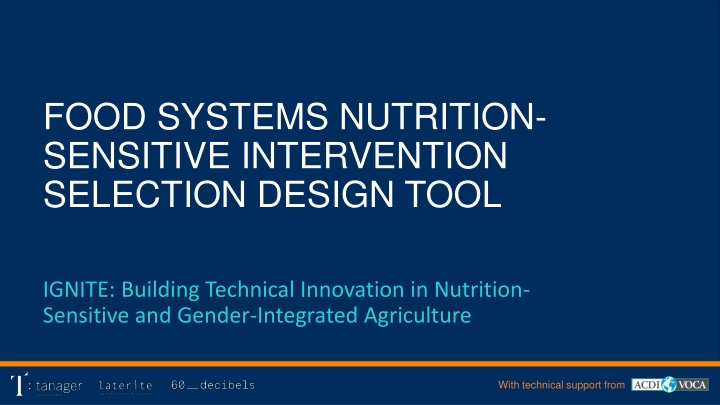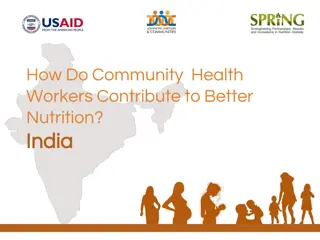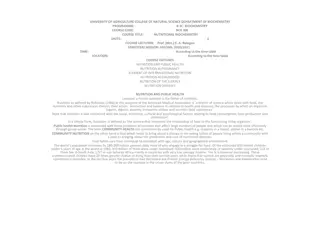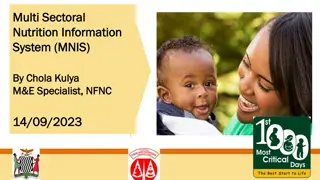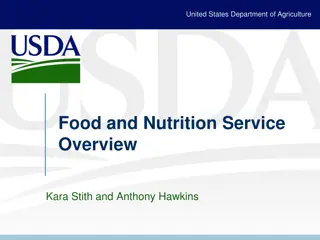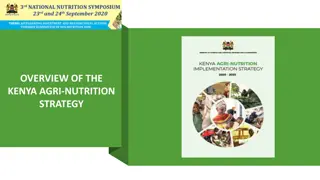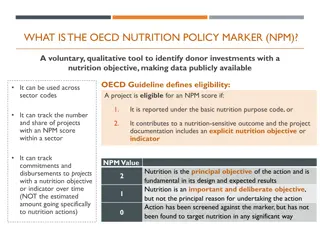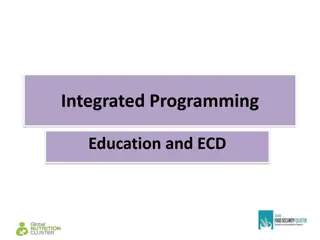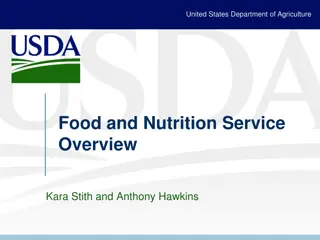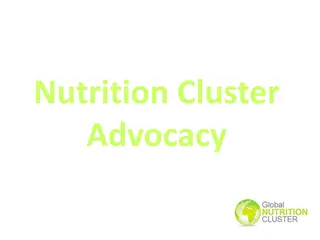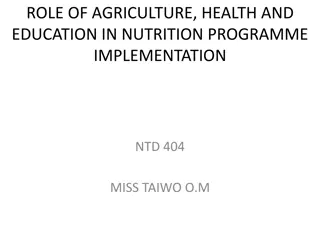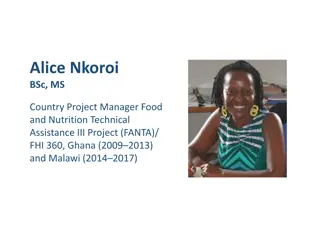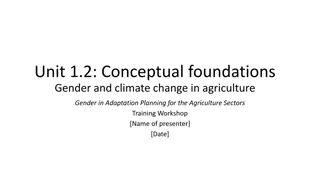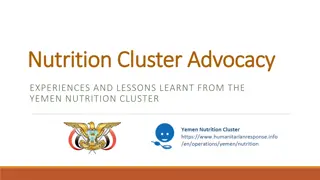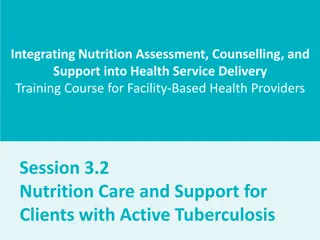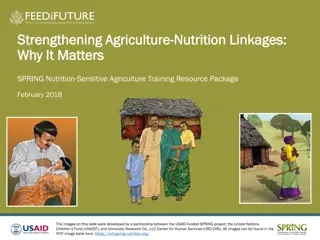Ignite: Innovative Nutrition-Sensitive Agriculture Tool
"Welcome to the Food Systems Nutrition-Sensitive Intervention Selection Design Tool, part of the IGNITE initiative. This tool aims to provide technical innovation in nutrition, integrating sensitivity and gender perspectives into agriculture practices. With support from experts, this tool assists in designing interventions for improved food systems nutrition."
Download Presentation

Please find below an Image/Link to download the presentation.
The content on the website is provided AS IS for your information and personal use only. It may not be sold, licensed, or shared on other websites without obtaining consent from the author.If you encounter any issues during the download, it is possible that the publisher has removed the file from their server.
You are allowed to download the files provided on this website for personal or commercial use, subject to the condition that they are used lawfully. All files are the property of their respective owners.
The content on the website is provided AS IS for your information and personal use only. It may not be sold, licensed, or shared on other websites without obtaining consent from the author.
E N D
Presentation Transcript
FOOD SYSTEMS NUTRITION- SENSITIVE INTERVENTION SELECTION DESIGN TOOL IGNITE: Building Technical Innovation in Nutrition- Sensitive and Gender-Integrated Agriculture With technical support from
WELCOME Welcome to the Food Systems Nutrition-Sensitive Intervention Selection (NSIS) Design Tool. This tool will walk through the process of identifying, designing, and implementing nutrition-sensitive interventions.
PREFACE The Food Systems NSIS Design Tool offers a non-exhaustive list of nutrition interventions that may be applicable to implementers working in agriculture, market systems, and/or food systems development. NSIS Design Tool users should work with their teams to determine which interventions are most relevant and how these interventions can be built into their work. IGNITE will continue to update the NSIS tool as needed, accounting for evolved thinking in the field and feedback from users.
DIRECTIONS The Food Systems NSIS Design Tool is a self-guided, choose your own adventure tool. Throughout the tool, users are prompted to select the food systems components and sub-components they are working in and subsequently, the nutrition interventions that they want to learn more about. The PowerPoint will advance automatically when you select the clickable buttons. To start, put the presentation in presentation mode by clicking slide show view in your PowerPoint program. Throughout the NSIS Design Tool, users will see opportunities for gender considerations, for the sub- components of the food system. If users want to dive deeper into gender integration, considerations, and transformative gender approaches, users can select the clickable gender icons (shown below) throughout the NSIS Design Tool to be taken to more thorough explanations. Gender with solid fill
WHERE IN THE FOOD SYSTEM IS YOUR PROJECT WORKING? FoodProcessing Food Processing Food trade / marketing Foodtrade/marketing Production Production Dump truck outline Blender outline Seed Packet outline Cause And Effect with solid fill FoodRetailing Food Retailing ConsumerDemand Enabling Environment Enabling Environment Consumer Demand Meeting outline Grocery bag with solid fill Head with gears with solid fill
PRODUCTION Select the box below that reflects the focus of your work in agriculture/livestock production: Agro-Input Supply and Service Delivery Farm/ Household Training on Agriculture Agro-Input Supply and Service Delivery Farm/ Household Training on Agriculture Value Chain Selection Producer/Farmer Organization Development Producer/Farmer Organization Development Value Chain Selection
Agro-Input Supply and Service Delivery Select an activity that the project is undertaking: Increasing Equitable Access to Inputs/Services Capacity Development of Input/Service Delivery Actors Increasing Equitable Access to Inputs/Services Capacity Development of Input/Service Delivery Actors
Increasing Equitable Access to Inputs/Services Capacity Development of Input/Service Delivery Actors Increasing Equitable Access to Inputs/Services Capacity Development of Input/Service Delivery Actors FoodEnvironment DomainsAffected Availability, Women s empowerment Availability, accessibility, Women s empowerment Availability, accessibility, Women s empowerment Potential Nutrition Intervention Increase access to seeds of nutrient-rich and biofortified crops so that nutrient-rich foods can be produced Increase access to safe storage containers and bags to decrease the risk of spoilage of production Increase access to inputs that will increase yield of nutrient-rich commodities Gender with solid fill Gender Integration Ensuring women have equitable access to inputs/ technology will support closing gender gaps in productivity and boost overall agricultural and nutrition outcomes.
Capacity Development of Input/Service Delivery Actors Capacity Development of Input/Service Delivery Actors Increasing Equitable Access to Inputs/Services Capacity Development of Input/Service Delivery Actors FoodEnvironment DomainsAffected Desirability Potential Nutrition Intervention Build capacity of agro-input and service providers to integrate nutrition messages into product marketing campaigns. *see x for potential areas of focus for message integration Build knowledge and capacity of agro-input and service providers to support farmers in diversifying into nutritious production (see x for areas of focus) Desirability, availability Build capacity of agro-input and service providers to appropriately market their products and services to women producers to increase their access and adoption of technologies that will increase yields Women s empowerment, Availability, accessibility Gender with solid fill Gender Integration Ensuring women have equitable access to inputs/ technology will support closing gender gaps in productivity and boost overall agricultural and nutrition outcomes.
Producer/Farmer Organization Development Select an activity that the project is undertaking: Marketing/Offtake Development Diversification Of Operations/Service Offerings Diversification Of Operations/Service Offerings Marketing/Offtake Development Women s Meaningful Participation In Producer Organization Producer Organization Member Training Development Of Storage Facilities Women s Meaningful Participation In Producer Organization Producer Organization Member Training Development Of Storage Facilities
Marketing/Offtake Development Women s Meaningful Participation In Producer Organization Diversification Of Operations/Service Offerings Producer Organization Member Training Development Of Storage Facilities Women s Meaningful Participation In Producer Organization Diversification Of Operations/Service Offerings Producer Organization Member Training Development Of Storage Facilities Marketing/Offtake Development FoodEnvironment DomainsAffected Affordability, desirability Availability, accessibility Availability, accessibility, price, affordability Potential Nutrition Intervention Integrate messaging to promote the use of income from the sale of commodities to use for purchasing nutrient-rich foods Integrate messaging on the importance of setting aside a portion of production for own consumption for nutrient-rich commodities when developing sale opportunities for producers Develop linkages between cooperatives and producer organizations with local markets so a portion of locally produced nutrient-rich foods stay in local market Gender with solid fill Gender Integration Ensuring women have equitable access to inputs/ technology will support closing gender gaps in productivity and boost overall agricultural and nutrition outcomes.
Diversification Of Operations/Service Offerings Women s Meaningful Participation In Producer Organization Producer Organization Member Training Marketing/Offtake Development Development Of Storage Facilities Women s Meaningful Participation In Producer Organization Diversification Of Operations/Service Offerings Producer Organization Member Training Development Of Storage Facilities Marketing/Offtake Development FoodEnvironment DomainsAffected Availability, Accessibility Availability, Accessibility, Desirability, Convenience, Potential Nutrition Intervention Support POs/FPO to diversify the commodities their members produce to include more nutrient-rich foods Support POs/FPOs to process commodities into a more desirable, shelf-stable, and/or nutritious food item Gender with solid fill Gender Integration Ensuring women have equitable access to inputs/ technology will support closing gender gaps in productivity and boost overall agricultural and nutrition outcomes. It is also important to ensure trainings incorporate attention to gender roles in commodity production, so that decisions to diversity commodities don t exacerbate inequities
Development Of Storage Facilities Women s Meaningful Participation In Producer Organization Diversification Of Operations/Service Offerings Producer Organization Member Training Marketing/Offtake Development Women s Meaningful Participation In Producer Organization Diversification Of Operations/Service Offerings Producer Organization Member Training Development Of Storage Facilities Marketing/Offtake Development FoodEnvironment DomainsAffected Availability, accessibility Convenience Availability, accessibility Potential Nutrition Intervention Promote aggregated safe storage facilities where producers can keep their production safe from pests and infestations for selling and/or consuming at a later date Develop farmer awareness of benefits of using improved storage facilities. Gender with solid fill Gender Integration Ensuring women have equitable access to inputs/ technology will support closing gender gaps in productivity and boost overall agricultural and nutrition outcomes.
Producer Organization Member Training Women s Meaningful Participation In Producer Organization Diversification Of Operations/Service Offerings Marketing/Offtake Development Development Of Storage Facilities Women s Meaningful Participation In Producer Organization Diversification Of Operations/Service Offerings Producer Organization Member Training Development Of Storage Facilities Marketing/Offtake Development FoodEnvironment DomainsAffected Desirability Potential Nutrition Intervention Integrate nutrition messaging into member training Gender with solid fill Gender Integration Ensuring women have equitable access to inputs/ technology will support closing gender gaps in productivity and boost overall agricultural and nutrition outcomes.
Womens Meaningful Participation In Producer Organization Diversification Of Operations/Service Offerings Producer Organization Member Training Marketing/Offtake Development Development Of Storage Facilities Women s Meaningful Participation In Producer Organization Diversification Of Operations/Service Offerings Producer Organization Member Training Development Of Storage Facilities Marketing/Offtake Development FoodEnvironment DomainsAffected Women s empowerment Potential Nutrition Intervention Promote women in leadership roles to increase their decision-making power Training and capacity development to promote policies that enable full participation of women (e.g. appropriate membership fees, convenient meeting times and places, and childcare during meetings/events.) Women s empowerment Gender with solid fill Gender Integration Groups that include women members and leaders benefit from diverse problem-solving and strengthened approaches to increasing productivity and achieving nutrition outcomes. When women as a group are not able to effectively voice concerns or propose solutions, POs/ FPOs can fail to understand or address challenges women face.
Farm/ Household Training on Agriculture Select an activity that the project is undertaking: Farm/HH Access To Inputs And Services Training On Household-level Processing Training On Good Agricultural Practices Farm/HH Access To Inputs And Services Training On Household- level Processing Training On Good Agricultural Practices
Farm/HH Access To Inputs And Services Training On Good Agricultural Practices Training On Household-level Processing Farm/HH Access To Inputs And Services Training On Good Agricultural Practices Training On Household-level Processing FoodEnvironment DomainsAffected Women s empowerment Potential Nutrition Intervention Integrate messaging on equitable decision-making regarding purchasing of agriculture inputs/services to increase their access and adoption of technologies that will increase yields Implement a household budgeting training to promote equitable decision-making and more informed decision-making on how to use household resources Affordability, Women s empowerment Gender with solid fill Gender Integration Ensuring women have equitable access to inputs/ technology will support closing gender gaps in productivity and boost overall agricultural and nutrition outcomes.
Training On Good Agricultural Practices Farm/HH Access To Inputs And Services Training On Household-level Processing Farm/HH Access To Inputs And Services Training On Good Agricultural Practices Training On Household-level Processing FoodEnvironment DomainsAffected Availability, Accessibility, Women s empowerment Availability, Accessibility, Desirability Potential Nutrition Intervention Provide training on good agricultural practices that will support producers to increase their productivity of target nutrient-rich foods for income generation and household consumption Integrate nutrition messaging on the target nutrient-rich commodities in agriculture training to increase desire to produce the food and to use for own-consumption Gender with solid fill Gender Integration Ensuring women have equitable access to inputs/ technology will support closing gender gaps in productivity and boost overall agricultural and nutrition outcomes.
Training On Household-level Processing Farm/HH Access To Inputs And Services Training On Good Agricultural Practices Farm/HH Access To Inputs And Services Training On Good Agricultural Practices Training On Household-level Processing FoodEnvironment DomainsAffected Availability Desirability Food safety Potential Nutrition Intervention Provide training on how to process the target nutrient-rich foods into other more desirable, shelf-stable, safe, and/or nutritious product Gender Integration Gender with solid fill Food processing roles are often divided along gender lines, which means trainings focused on household-level processing are likely to be targeted at women because they are commonly associated with domestic responsibilities. If trainings are not gender-specific, it is important to include both men and women because ensuring women have equitable access to training will support closing gender gaps in decision-making and boost overall agricultural and nutrition outcomes.
Value Chain Selection FoodEnvironment DomainsAffected Availability, accessibility, affordability Potential Nutrition Intervention Promote the production of crops and livestock that will positively contribute to the availability of nutritious food at the household and/or market Gender Considerations Gender with solid fill Roles and responsibilities in crop production and livestock rearing tend to be assigned according to traditional gender roles. Recognizing the different roles men and women play, and their different levels of access to/control over resources, decision-making, and time burdens is important to consider in the selection of crop and livestock varieties.
FOOD TRADE/MARKETING Select the box below that reflects the focus of your work in food trade/marketing: Food Commodity Storage Marketing/Distribution of Commodities Food Safety In Food Storage, Transport, And Trade Food Safety In Food Storage, Transport, And Trade Marketing/Distribution of Commodities Food Commodity Storage
Food Commodity Storage Select an activity that the project is undertaking: Market-level Or Producer Organization-level Storage Facilities Developed Household-level Storage Capacities Enhanced Market-level Or Producer Organization-level Storage Facilities Developed Household-level Storage Capacities Enhanced
Market-level Or Producer Organization-level Storage Facilities Developed Household-level Storage Capacities Enhanced Market-level Or Producer Organization-level Storage Facilities Developed Household-level Storage Capacities Enhanced FoodEnvironment DomainsAffected Food Safety, availability, accessibility Potential Nutrition Intervention Promote safe storage facilities where producers can keep their production safe from pests and infestations for selling and/or consuming at a later date Gender with solid fill Gender Integration Ensuring women have equitable access to inputs/ technology will support closing gender gaps in productivity and boost overall agricultural and nutrition outcomes.
Household-level Storage Capacities Enhanced Market-level Or Producer Organization-level Storage Facilities Developed Market-level Or Producer Organization-level Storage Facilities Developed Household-level Storage Capacities Enhanced FoodEnvironment DomainsAffected Food Safety, availability, accessibility Food Safety Potential Nutrition Intervention Increase access to safe storage containers and bags to decrease the risk of spoilage of production for selling and/or consuming at a later date Disseminate messages on the importance of use of safe storage containers for improving food safety and family health Gender with solid fill Gender Integration Programs promoting improved storage technologies need to consider and address gender constraints to ensure that women benefit from the process, which can improve adoption and promote overall agriculture and nutrition outcomes.
Marketing/Distribution Of Commodities Select an activity that the project is undertaking: Farm-level Marketing/Offtake Enhanced Trade Of Foods (Inside And Outside The Implementation Area) Food Processors And Retailers Marketing Strategies Developed Farm-level Marketing/Offtake Enhanced Trade Of Foods (Inside And Outside The Implementation Area) Food Processors And Retailers Marketing Strategies Developed
Farm-level Marketing/Offtake Enhanced Trade Of Foods (Inside And Outside The Implementation Area) Food Processors And Retailers Marketing Strategies Developed Farm-level Marketing/Offtake Enhanced Trade Of Foods (Inside And Outside The Implementation Area) Food Processors And Retailers Marketing Strategies Developed FoodEnvironment DomainsAffected Affordability Potential Nutrition Intervention Integrate messaging to promote the use of income from the sale of commodities to use for purchasing nutrient-rich foods Develop linkages with local producers and food vendors to keep a portion of local production in the marketplace Availability, Price, accessibility Develop a pipeline of food distributors Availability, Price, accessibility Gender with solid fill Gender Integration Ensuring both men and women are informed about the value of ensuring diverse nutritious foods are locally available will stimulate the local food system and increase nutrition outcomes.
Trade Of Foods (Inside And Outside The Implementation Area) Farm-level Marketing/Offtake Enhanced Food Processors And Retailers Marketing Strategies Developed Farm-level Marketing/Offtake Enhanced Trade Of Foods (Inside And Outside The Implementation Area) Food Processors And Retailers Marketing Strategies Developed FoodEnvironment DomainsAffected Availability, Price, accessibility Potential Nutrition Intervention Develop linkages between wholesalers and traders of nutrient-rich foods that are not produced in the program implementation area with vendors at local food marketplaces in the implementation area Gender with solid fill Gender Integration Ensuring women and men have equitable access to trade opportunities. Women often have vital roles as small-scale processors and retailers and require equitable access to raw materials to thrive as business owners while supplying nutritious foods to their local markets.
Food Processors And Retailers Marketing Strategies Developed Farm-level Marketing/Offtake Enhanced Trade Of Foods (Inside And Outside The Implementation Area) Farm-level Marketing/Offtake Enhanced Trade Of Foods (Inside And Outside The Implementation Area) Food Processors And Retailers Marketing Strategies Developed FoodEnvironment DomainsAffected Availability, Price, accessibility Potential Nutrition Intervention Support processors and food retailers to market their foods in rural, last-mile markets Gender with solid fill Gender Integration Ensuring women and men have equitable access to information about nutrient rich foods and the opportunity to purchase them will support closing gender gaps in decision-making and boost overall nutrition outcomes.
Food Safety In Food Storage, Transport, And Trade Select an activity that the project is undertaking: Food Safety, Sanitation, And Hygiene Is Enhanced Along Food Distribution Food Safety, Sanitation, And Hygiene Is Enhanced Along Food Distribution
Food Safety, Sanitation, And Hygiene Is Enhanced Along Food Distribution Food Safety, Sanitation, And Hygiene Is Enhanced Along Food Distribution FoodEnvironment DomainsAffected Food safety Potential Nutrition Intervention Increase food distributors (e.g., wholesalers, traders) access to technologies that would increase food safety between points of sale (e.g., cold chain enhancements) Train food distributors (e.g., wholesalers, traders) on food safety, sanitation, and hygiene protocols specific to their commodity of focus Food safety Gender with solid fill Gender Integration Ensuring women and men have equitable access to information about food safety, sanitation, and hygiene will support closing gender gaps in agribusiness and boost overall nutrition outcomes.
PROCESSING Select the box below that reflects the primary focus of your work in processing: Farm/ Household Training On Food Processing Commercial Training On Food Processing Farm/ Household Training On Food Processing Commercial Training On Food Processing Consumer Marketing By Food Processors Marketing/ Distribution Of Commodities By Food Processors Marketing/ Distribution Of Commodities By Food Processors Consumer Marketing By Food Processors
Farm/Household Training On Food Processing Select an activity that the project is undertaking: Training On Household-level Processing Training On Household- level Processing
Training On Household-level Processing Training On Household-level Processing FoodEnvironment DomainsAffected Availability Desirability Food safety, convenience Potential Nutrition Intervention Provide training on how to process and/or preserve the target nutrient-rich foods into other more desirable, shelf-stable, safe, and/or nutritious products (e.g., raw milk into yogurt) Gender with solid fill Gender Integration Food processing roles are often divided along gender lines, which means trainings focused on household-level processing are likely to be targeted at women because they are commonly associated with domestic responsibilities. If trainings are not gender-specific, it is important to include both men and women because ensuring women have equitable access to training will support closing gender gaps in decision-making and boost overall agricultural and nutrition outcomes.
Commercial Training On Food Processing Select an activity that the project is undertaking: Diversification Of Processors Products Food Safety Enhanced In Food Processing Product Packaging Enhanced Diversification Of Processors Products Food Safety Enhanced In Food Processing Product Packaging Enhanced
Diversification Of Processors Products Food Safety Enhanced In Food Processing Product Packaging Enhanced Food Safety Enhanced In Food Processing Diversification Of Processors Products Product Packaging Enhanced FoodEnvironment DomainsAffected Availability, desirability, food safety Availability, Potential Nutrition Intervention Increase processor access to technologies that allow them to process foods into more nutritious, shelf-stable, desirable, or safe products (e.g., drying technologies) Develop fortification capacities by increasing access to necessary fortification technology and training on appropriate processes for standardized fortification Develop processors capacities to process the target commodity into a more nutritious product (e.g., adding ground soybean to maize flour) Availability, desirability Build processors capacity to develop target commodities into a more shelf-stable product (e.g., fish into dried fish) Availability, safety Build processors capacity to develop a product that is more convenient for target, nutrient-rich commodities (e.g., pre-washed and plucked spinach) Build processors capacity to develop target commodities into a product more desirable product, accounting for local preferences Convenience Desirability Gender Integration Gender with solid fill Food processing roles are often divided along gender lines, which means trainings focused on household-level processing are likely to be targeted at women because they are commonly associated with domestic responsibilities. If trainings are not gender-specific, it is important to include both men and women because ensuring women have equitable access to training will support closing gender gaps in decision-making and boost overall agricultural and nutrition outcomes.
Food Safety Enhanced In Food Processing Diversification Of Processors Products Product Packaging Enhanced Food Safety Enhanced In Food Processing Diversification Of Processors Products Product Packaging Enhanced FoodEnvironment DomainsAffected Food safety Potential Nutrition Intervention Train processors on standard food safety, sanitation, and hygiene protocols Train processors on food safety, sanitation, and hygiene protocols specific to their commodity of focus Food safety
Product Packaging Enhanced Diversification Of Processors Products Food Safety Enhanced In Food Processing Food Safety Enhanced In Food Processing Diversification Of Processors Products Product Packaging Enhanced FoodEnvironment DomainsAffected Food safety, desirability Potential Nutrition Intervention Train processors on product packaging techniques that will increase the food safety of their product Food safety Increase processors access to food packaging products that will increase the food safety of the product Train processors on different packaging sizes that account for food purchasing power of lower income consumers (e.g., smaller packages) Price, affordability
Marketing/ Distribution Of Commodities By Food Processors Select an activity that the project is undertaking: Food Processors And Retailers Marketing Strategies Developed Food Processors And Retailers Marketing Strategies Developed
Food Processors And Retailers Marketing Strategies Developed Food Processors And Retailers Marketing Strategies Developed FoodEnvironment DomainsAffected Availability, accessibility, price Potential Nutrition Intervention Support processors and food retailers to market their foods in rural, last-mile markets Gender with solid fill Gender Integration Ensuring women and men processors have equitable access to business relationships and capacity-building opportunities. In developing marketing messaging, ensure women and men as customers have equitable information about nutrient rich foods and the opportunity to purchase them
Consumer Marketing By Food Processors Select an activity that the project is undertaking: Consumer Marketing Capacities Of Processors Developed Consumer Marketing Capacities Of Processors Developed
Consumer Marketing Capacities Of Processors Developed Consumer Marketing Capacities Of Processors Developed FoodEnvironment DomainsAffected Desirability Potential Nutrition Intervention Build capacity of processors to market their products with nutrition messaging integrated Gender with solid fill Gender Integration Ensuring women and men processors have equitable access to business relationships and capacity-building opportunities. In developing marketing messaging, ensure women and men as customers have equitable information about nutrient rich foods and the opportunity to purchase them
FOOD RETAILING Select the box below that reflects the primary focus of your work in food retailing: Location Of Food Retailing Social Marketing By Vendors Location Of Food Retailing Social Marketing By Vendors Product Characteristics Good Governance At Markets Good Governance At Markets Product Characteristics
Location of Food Retailing Select an activity that the project is undertaking: Development Of New Retail Locations For Nutrient-rich Foods Local Market Infrastructure Development Development Of New Retail Locations For Nutrient-rich Foods Local Market Infrastructure Development
Development Of New Retail Locations For Nutrient- rich Foods Local Market Infrastructure Development Development Of New Retail Locations For Nutrient-rich Foods Local Market Infrastructure Development FoodEnvironment DomainsAffected Availability, accessibility, price, affordability Potential Nutrition Intervention Increase the number of vendors selling target, nutrient-rich commodities that are not produced in the program implementation area Gender with solid fill Gender Integration Ensuring women and men have equitable access to information about nutrient rich foods and the opportunity to purchase them will support closing gender gaps in decision-making and boost overall nutrition outcomes.
Local Market Infrastructure Development Development Of New Retail Locations For Nutrient-rich Foods Development Of New Retail Locations For Nutrient-rich Foods Local Market Infrastructure Development FoodEnvironment DomainsAffected Availability, accessibility Potential Nutrition Intervention Advocate for and/or build improved market infrastructure, particularly where markets are sparse and food isn t readily available to consumers, to increase food vending opportunities in the area Promote the use of structured stalls and/or separated areas for target commodities to increase visibility to consumers and/or improved food safety (e.g., keep meat separated from produce) Food safety, accessibility, desirability Gender with solid fill Gender with solid fill Gender Integration Ensuring women have equitable access to markets where nutritious foods are sold will promote gender equity in decision-making and improve nutrition outcomes.
Social Marketing By Vendors Select an activity that the project is undertaking: Vendors Consumer Marketing Capacities Developed Vendors Consumer Marketing Capacities Developed
Vendors Consumer Marketing Capacities Developed Vendors Consumer Marketing Capacities Developed FoodEnvironment DomainsAffected Desirability Potential Nutrition Intervention Build capacity of vendors to market their products with nutrition messaging integrated Gender with solid fill Gender Integration Ensuring women and men processors have equitable access to business relationships and capacity-building opportunities. In developing marketing messaging, ensure women and men as customers have equitable information about nutrient rich foods and the opportunity to purchase them
Product Characteristics Select an activity that the project is undertaking: Product Sizes Optimized Food Safety, Sanitation, And Hygiene Considerations Integrated In Food Retailing Food Safety, Sanitation, And Hygiene Considerations Integrated In Food Retailing Product Sizes Optimized
Product Sizes Optimized Food Safety, Sanitation, And Hygiene Considerations Integrated In Food Retailing Food Safety, Sanitation, And Hygiene Considerations Integrated In Food Retailing Product Sizes Optimized FoodEnvironment DomainsAffected Price, Affordability, accessibility Desirability, Food safety Potential Nutrition Intervention Develop vendors understanding of their customer base and potential benefits of selling different sized products to reach consumers of different socioeconomic status and accessibility constraints Promote vendors understanding and use of improved packaging that is higher quality, more durable, increases shelf-stability, and is pest- resistant Gender Integration Gender with solid fill Ensuring women have equitable access to physical commodities will promote gender equity in access to nutritious foods, promote equitable decision-making and improve nutrition outcomes.
Food Safety, Sanitation, And Hygiene Considerations Integrated In Food Retailing Product Sizes Optimized Food Safety, Sanitation, And Hygiene Considerations Integrated In Food Retailing Product Sizes Optimized FoodEnvironment DomainsAffected Food safety Potential Nutrition Intervention Train food vendors on standard food safety, sanitation, and hygiene protocols Train food vendors on food safety, sanitation, and hygiene protocols specific to their commodity of focus Food safety Support food vendors to market their improved food safety, sanitation, and hygiene practices to consumers Desirability Gender with solid fill Gender Integration Ensuring women have equitable access to training and information will support closing gender gaps in decision-making and boost overall agricultural and nutrition outcomes.
